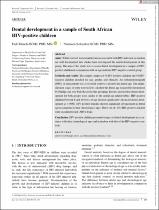| dc.contributor.author | Titinchi, F | |
| dc.date.accessioned | 2022-12-05T10:42:56Z | |
| dc.date.available | 2022-12-05T10:42:56Z | |
| dc.date.issued | 2018 | |
| dc.identifier.other | 10.1111/scd.12353 | |
| dc.identifier.uri | http://hdl.handle.net/10566/8200 | |
| dc.description.abstract | Aims: While oral soft tissue manifestations associated with HIV-infection in children
are well documented, few studies have investigated the dental development of this
group. The aim of this study was to assess dental development in a sample of HIVpositive children in comparison with an age-matched HIV-negative control group.
Methods and results: The sample comprised 44 HIV-positive children and 44 HIVnegative children matched for age, gender, and ethnicity. An orthopantomograph
(OPG) of each patient was assessed in order to calculate the dental age. The mineralization stages of teeth were used to calculate the dental age using tables formulated
by Phillips and van Wyk-Kotze for this grouping. Results showed that dental development for both groups were similar to the dental age-related tables. HIV-positive
children between 8 and 10 years of age showed significantly advanced dental development (p = 0.04). HIV-positive females showed significant advancement in dental
age as compared to their chronological ages. Thirty-six (81.8%) HIV-positive children
were on antiretroviral (ARV) drugs.
Conclusion: HIV-positive children presented stages of dental development in accordance with their chronological ages and in tandem with that of the HIV-negative controls. | en_US |
| dc.language.iso | en | en_US |
| dc.publisher | UWC | en_US |
| dc.subject | antiretroviral therapy | en_US |
| dc.subject | dental age | en_US |
| dc.subject | human immunodeficiency virus | en_US |
| dc.subject | pediatric dentistry | en_US |
| dc.subject | orthodontic treatment planning | en_US |
| dc.title | Dental development in a sample of South African HIV-positive children | en_US |
| dc.type | Article | en_US |

